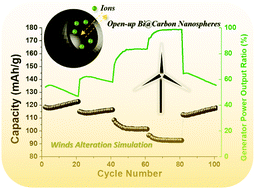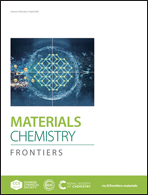Fast-response/stable Ni–Bi cells achieved using hollowed-out Bi@carbon nanospheres: a preferred electricity storage choice to couple with clean energy harvesting†
Abstract
Metallic bismuth (Bi) is a burgeoning choice of anode for rechargeable aqueous batteries given its large volumetric capacity, proper operating potential and highly reversible redox behavior. However, its further progress for full-cell implementation is unfortunately impeded due to the inferior anodic stability of Bi over long-term operation. Worse still, its low melting point (∼271 °C) prevents the use of conventional optimizing techniques (e.g., carbon modification) to alleviate tough anodic fading issues. We herein propose an unusual engineering protocol to enable Bi nanounits packaged into carbon sheaths using NH4Bi3F10 nanospheres as initiating materials. Of particular note is that the high electrovalent bond of Bi–F plays a key role in promoting the bismuth thermal durability beyond 400 °C. Such Bi@carbon hybrids have special hollowed-out nanoscale features, with highly accessible surface areas, smooth ionic transport channels and robust mechanical properties against electrode degradation. The as-built anodes possess impressive specific capacity and rate capability (∼53.9% capacity retention at 20 A g−1), as well as prolonged cyclic lifespan (beyond 80% capacity retention after 103 cycles). More significantly, we further affirm the unique anodic phase conversions of “Bi ↔ Bi(OH)3” on a real-time basis using characterizations/post-analysis at different cyclic stages. Our assembled Ni–Bi cells with notable peak energy/power densities of ∼82.32 W h kg−1/∼15.7 kW kg−1 and fast-response and stable behavior, may be fit for green energy-harvesting use.



 Please wait while we load your content...
Please wait while we load your content...